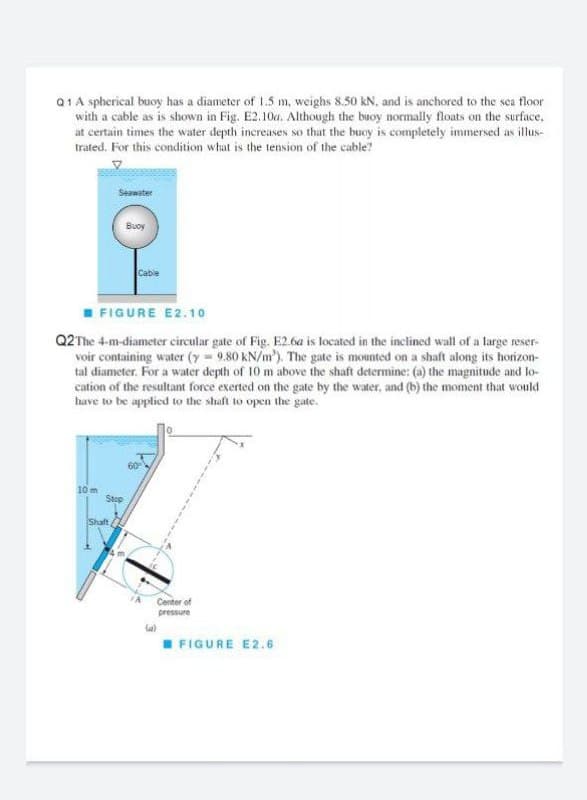a1 A spherical buoy has a diameter of 1.5 m, weighs 8.50 kN, and is anchored to the sea floor with a cable as is shown in Fig. E2.10a. Although the buoy normally floats on the surface, at certain times the water depth increases so that the buoy is completely immersed as illus- trated. For this condition what is the tension of the cable? Seawater Buoy Cable
a1 A spherical buoy has a diameter of 1.5 m, weighs 8.50 kN, and is anchored to the sea floor with a cable as is shown in Fig. E2.10a. Although the buoy normally floats on the surface, at certain times the water depth increases so that the buoy is completely immersed as illus- trated. For this condition what is the tension of the cable? Seawater Buoy Cable
Elements Of Electromagnetics
7th Edition
ISBN:9780190698614
Author:Sadiku, Matthew N. O.
Publisher:Sadiku, Matthew N. O.
ChapterMA: Math Assessment
Section: Chapter Questions
Problem 1.1MA
Related questions
Question

Transcribed Image Text:Q1 A spherical buoy has a diameter of 1.5 m, weighs 8.50 kN, and is anchored to the sea floor
with a cable as is shown in Fig. E2.10a. Although the buoy normally floats on the surface,
at certain times the water depth increases so that the buoy is completely immersed as illus-
trated. For this condition what is the tension of the cable?
Seawater
Buoy
Cabie
I FIGURE E2.10
Q2The 4-m-diameter circular gate of Fig. E2.6a is located in the inclined wall of a large reser-
voir containing water (y 9.80 kN/m). The gate is mounted on a shaft along its horizon-
tal diameter. For a water depth of 10 m above the shaft determine: (a) the magnitude and lo-
cation of the resultant force exerted on the gate by the water, and (b) the moment that would
have to be applied to the shaft to open the gate.
10 m
Stop
Shaft
Center of
pressure
I FIGURE E2.6
Expert Solution
This question has been solved!
Explore an expertly crafted, step-by-step solution for a thorough understanding of key concepts.
This is a popular solution!
Trending now
This is a popular solution!
Step by step
Solved in 2 steps with 2 images

Knowledge Booster
Learn more about
Need a deep-dive on the concept behind this application? Look no further. Learn more about this topic, mechanical-engineering and related others by exploring similar questions and additional content below.Recommended textbooks for you

Elements Of Electromagnetics
Mechanical Engineering
ISBN:
9780190698614
Author:
Sadiku, Matthew N. O.
Publisher:
Oxford University Press

Mechanics of Materials (10th Edition)
Mechanical Engineering
ISBN:
9780134319650
Author:
Russell C. Hibbeler
Publisher:
PEARSON

Thermodynamics: An Engineering Approach
Mechanical Engineering
ISBN:
9781259822674
Author:
Yunus A. Cengel Dr., Michael A. Boles
Publisher:
McGraw-Hill Education

Elements Of Electromagnetics
Mechanical Engineering
ISBN:
9780190698614
Author:
Sadiku, Matthew N. O.
Publisher:
Oxford University Press

Mechanics of Materials (10th Edition)
Mechanical Engineering
ISBN:
9780134319650
Author:
Russell C. Hibbeler
Publisher:
PEARSON

Thermodynamics: An Engineering Approach
Mechanical Engineering
ISBN:
9781259822674
Author:
Yunus A. Cengel Dr., Michael A. Boles
Publisher:
McGraw-Hill Education

Control Systems Engineering
Mechanical Engineering
ISBN:
9781118170519
Author:
Norman S. Nise
Publisher:
WILEY

Mechanics of Materials (MindTap Course List)
Mechanical Engineering
ISBN:
9781337093347
Author:
Barry J. Goodno, James M. Gere
Publisher:
Cengage Learning

Engineering Mechanics: Statics
Mechanical Engineering
ISBN:
9781118807330
Author:
James L. Meriam, L. G. Kraige, J. N. Bolton
Publisher:
WILEY